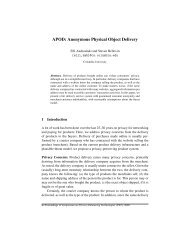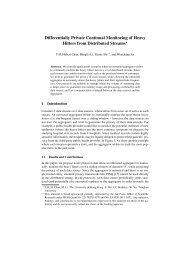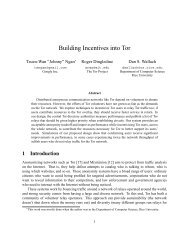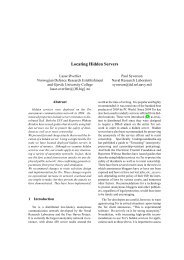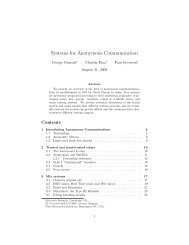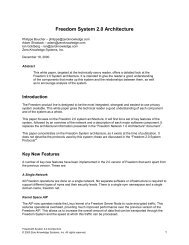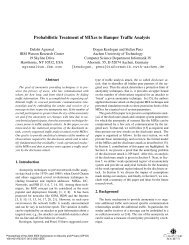Hiding Routing Information - Onion Routing
Hiding Routing Information - Onion Routing
Hiding Routing Information - Onion Routing
You also want an ePaper? Increase the reach of your titles
YUMPU automatically turns print PDFs into web optimized ePapers that Google loves.
David M. Goldschlag, Michael G. Reed, and Paul F. Syverson. \<strong>Hiding</strong> <strong>Routing</strong> <strong>Information</strong>,"Workshop on <strong>Information</strong> <strong>Hiding</strong>, Cambridge, UK, May, 1996.this circuit will identify the responder.The second command is data. The second role of the initiator's Proxy/<strong>Routing</strong>Node is to pass a stream of data from the initiator along the virtual circuittogether with other control information for the responder's Proxy/<strong>Routing</strong> Node.To do this, he breaks the incoming stream into (at most) payload sized chunks,and repeatedly pre-crypts each chunk using the inverse of the cryptographicoperations specied in the onion, innermost rst. The function/key pairs thatare applied, and the virtual circuit identier of the connection to the next nodeare obtained from a table. The header eld for each payload is the label ofthe connection and a data command. Each subsequent node looks at its table,obtaining the cryptographic function/key pair associated with the circuit (forthe appropriate direction) and the virtual circuit identier of the connection tothe next node. It then peels o a layer of cryptography and forwards the peeledpayload to the next node. Once the data reaches the responder's proxy, its nalcryption will produce the plaintext that is to be processed or forwarded to theresponder.The data command can also be used to move data from the responder'sProxy/<strong>Routing</strong> Node to the initiator's Proxy/<strong>Routing</strong> Node. The responder'sProxy/<strong>Routing</strong> Node obtains the cryptographic function/key pair and the virtualcircuit identier for the next node from its tables, and crypts the stream.It breaks the crypted stream into payload sized chunks and forwards them tothe next node with the appropriate control eld. Each subsequent node furtherstream crypts each payload using the appropriate function/key associated withthat virtual circuit. Once a messages arrives at the initiator's Proxy/<strong>Routing</strong>Node he looks at his table and applies the inverse of the backward cryptographicoperations specied in the onion, outermost rst, to this stream to obtain theplaintext. The plaintext is forwarded to the initiator.The third command is destroy which is used to tear down a virtual circuitwhen it is no longer needed or in response to certain error conditions. Noticethat destroy messages can be initiated by any node along a virtual circuit, and itis a node's obligation to forward the destroy messages in the appropriate directions.(A node initiating a destroy message in an active virtual circuit forwardsit in both directions. A node that receives a destroy message passes it alongin the same direction.) The payload of a destroy command is empty padding.Nonetheless, this payload is still crypted with the appropriate function/key pair.In addition to the destroy command, the control eld contains the virtual circuitidentier of the recipient of the destroy command. Upon receipt of a destroycommand a node deletes the table entries associated with that virtual circuit.5 Vulnerabilities<strong>Onion</strong> <strong>Routing</strong> is not invulnerable to trac analysis attacks. With enough data,it is still possible to analyze usage patterns and make educated guesses aboutthe routing of messages. Also, since our application requires real time communication,it may be possible to detect the near simultaneous opening of socket11



